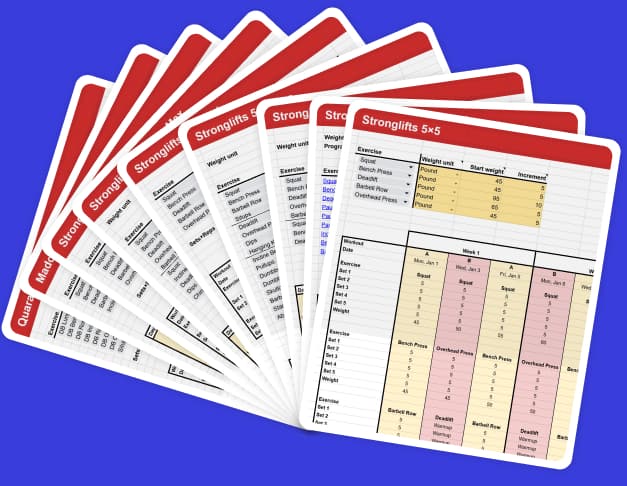On Stronglifts 5×5 your goal is to increase the weight you lift over time.
You’re not trying to get pumped, sore, fatigued or sweaty (although that can happen). You’re trying to lift more weight. The stronger you get, the more muscular you’ll be. Strength is size. More strength is more muscle.
Progress by adding 5lb or less to the bar. That’s 2.5lb or 1.25kg/side. You can add this every one, two, three or even five workouts. Don’t lift the same weight for six months. Challenge yourself to do more. This is progressive overload and it’s crucial for building muscle and strength.
In this guide I’ll show you how to progress on Stronglifts 5×5.
Contents
- Progressive Overload: The Key to Building Muscle and Strength
- The Legend of Milo and Progressive Overload
- The Science of Progressive Overload
- When to Add Weight on Stronglifts 5×5
- Good Form, Not Ego Lifting
- How Much Weight to Add on Stronglifts 5×5
- How Often to Add Weight
- You Don’t Have to Add Weight Every Workout
- Frequently Asked Questions
- References
Join the Stronglifts community to get free access to all the spreadsheets for every Stronglifts program. You’ll also get daily email tips to stay motivated. Enter your email below to sign up today for free.
Progressive Overload: The Key to Building Muscle and Strength
Progressive overload means gradually increasing the demands placed on your muscles to stimulate growth and strength gains. The easiest way to do this is by gradually increasing the weight on the bar.
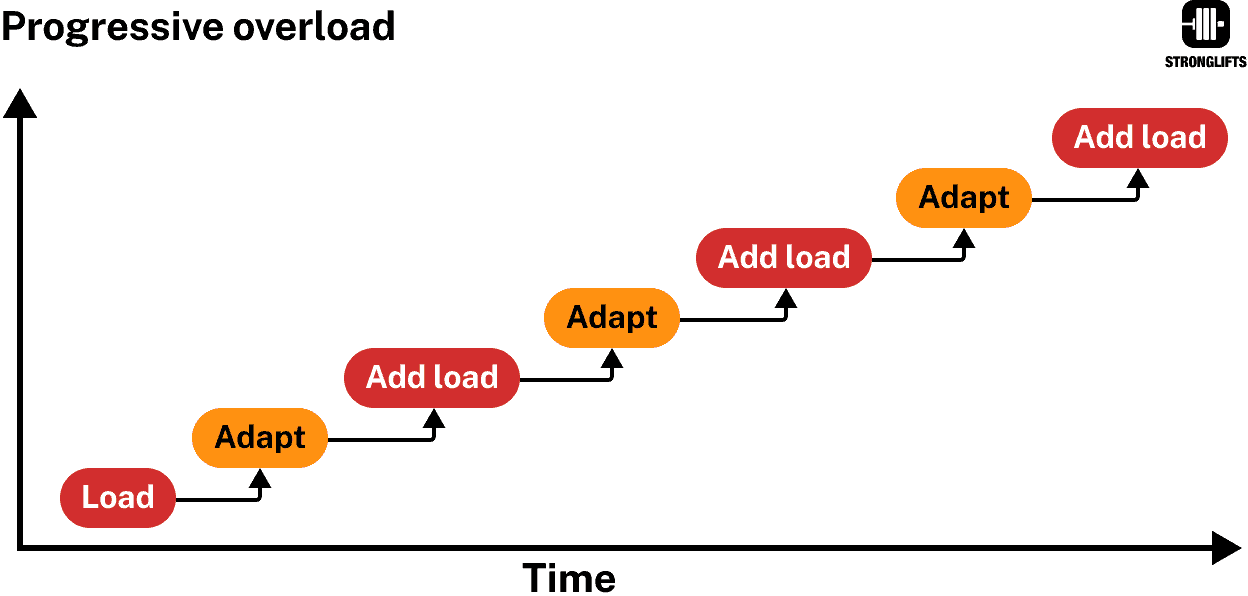
Progressive overload is one of the fundamental principles of resistance training (1). Programs that lack progressive overload can’t be effective. They neglect the essential basics needed for getting results. All the best programs center around progressive overload. If they didn’t, they wouldn’t work and so they wouldn’t be the best programs.
Progressive overload is like getting a tan. You need to gradually increase your sun exposure to achieve a darker tan. If you don’t spend more time in the sun, your tan won’t get any darker. Similarly, if you lift the same weight than you did six months ago, then your muscles won’t be any bigger or stronger. You need to add weight on the bar for that to happen.
In study after study, scientists instruct participants to add weight next workout if they successfully completed their sets. Scientists know that progressive overload is crucial for building muscle and strength. Here’s a quote from the American College of Sports Medicine (2)…
As the trained muscles strengthen and enlarge (hypertrophy), the resistance must be progressively increased if additional gains are to be accrued.
The American College of Sports Medicine
If you don’t lift more weight than you did six months ago, you won’t look any different. Adding weight on the bar tells your body to build muscle so it can handle heavier weights. To build muscle as a drug-free lifter, you need to progressively increase the tension by adding weight over time. Muscular tension is the primary driver of muscle growth (3).
If the weight didn’t matter, we would all be big like Ronnie Coleman by our teens. Our muscles are always under tension as they resist gravity when we move. However this tension is too light to make our muscles bigger and stronger. To stimulate growth, we need to increase the tension on our muscles. We need to lift heavier weights.
This. means that if you double your Squat from 150lb to 300lb, your legs will be bigger. Double your Bench from 100lb to 200lb, and your chest will be bigger. Double your Deadlift from 200lb to 400lb, and your back will be bigger. Strength is size. More strength is more muscle.

This doesn’t mean that the strongest lifter will always be the biggest lifter. Genetics matter. Some people build more muscle despite doing the same program (4, 5, 6, 7). And there’s the issue of drugs (8). “Strength is size” is therefore not about comparing yourself to others. It’s about comparing your weaker body to your stronger body. It’s a personal journey. Your stronger self will have bigger muscles than your weaker self. Your legs will be bigger when you Squat 5x300lb than 5x150lb. More strength is more muscle.
Yes, building muscle is that simple. It’s not easy. It takes consistent effort, dedication and hard work. And it’s important to focus on good form before trying to lift a lot of weight on compound exercises like Squats and Deadlift. But if you consistently apply the fundamental principle of progressive overload by challenging yourself to do more over time, you’ll achieve impressive muscle and strength gains that everyone around you will notice.
The powerful effects of applying the progressive overload principle have been known for millennia…
The Legend of Milo and Progressive Overload
In ancient Greece, the wrestler Milo from Croton trained for the Olympics by carrying a calf on his back every single day.
Each day the calf grew larger and heavier. This progressively increased the weight Milo had to carry. The calf eventually turned into a bull. As a result, Milo’s muscles became bigger and stronger.
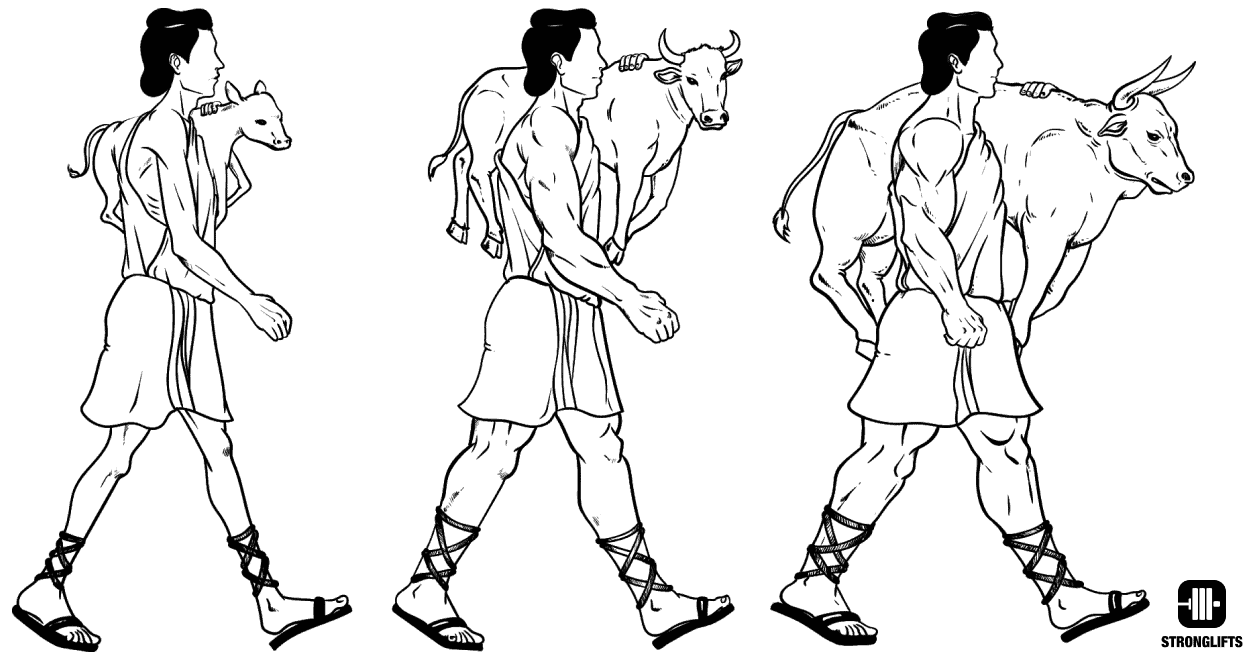
This simple training program helped Milo become the best wrestler of his time. He went on to win the Olympics six times.
The legend of Milo illustrates the principle of progressive overload. He started with a light weight and progressively lifted more over time. This forced his body to build bigger and stronger muscles to lift the growing calf. Strength is size. More strength is more muscle.
The Science of Progressive Overload
In the 1940s, Dr. Thomas L. DeLorme conducted several studies on progressive overload (9).
DeLorme’s journey began when he got sick in high school. He was stuck in bed for four months. Doctors told him he would never be able to do physically hard tasks again. DeLorme didn’t like what he heard and found inspiration in muscle magazines. He started to lift.
By 1939, DeLorme had become a competitive lifter. He could Deadlift 503lb and Clean & Jerk 250lb (9, 10). His body-weight increased from a skinny and frail 140lb to a muscular and strong 185lb.
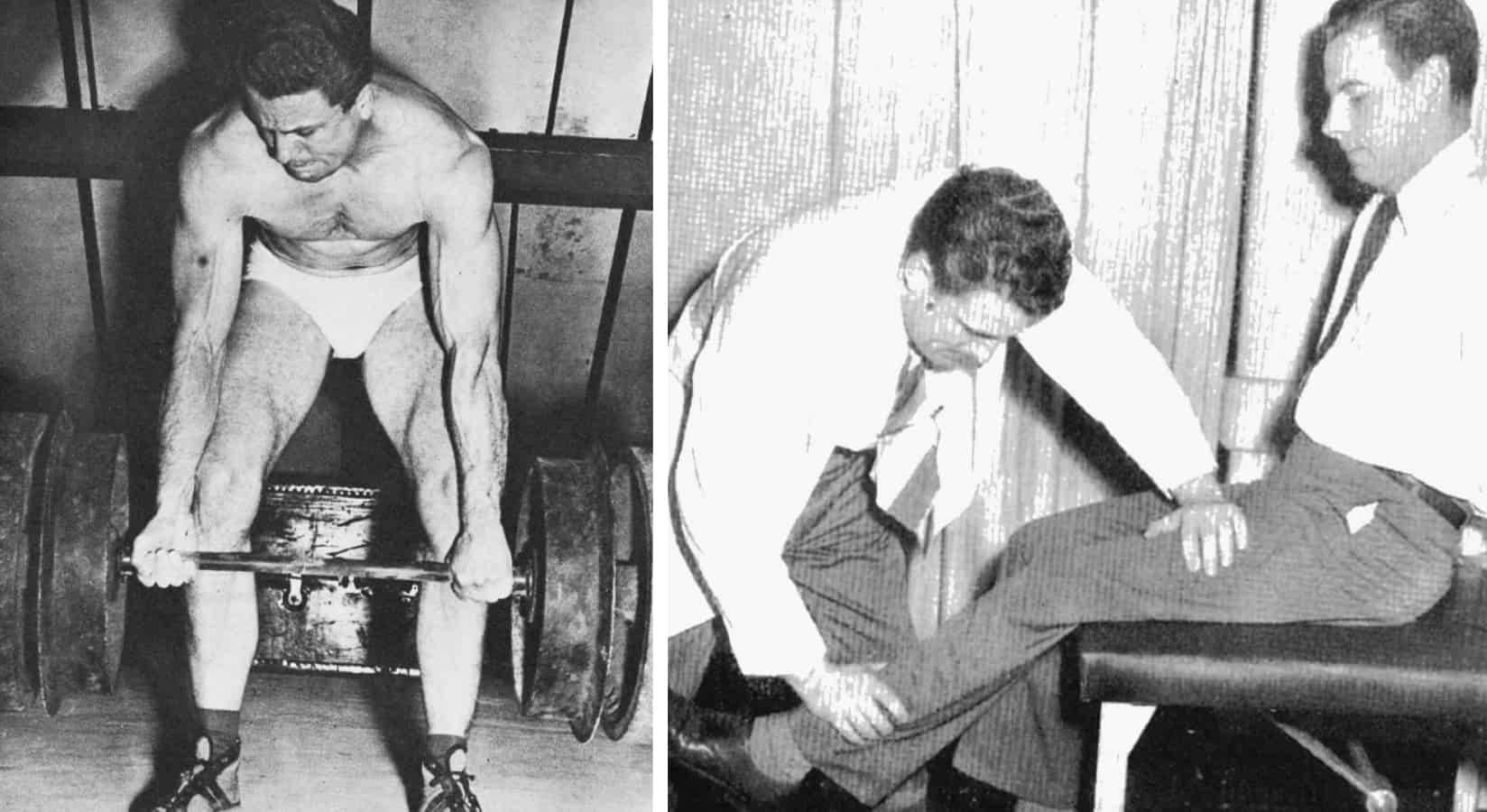
During World War II, many American soldiers got injured. Recovery could take nine months. Hospitals were overrun. Dr DeLorme was called for help. He quickly realized they needed faster recovery methods.
DeLorme started experimenting with progressive overload on injured soldiers. He had them start with a light weight. If they could complete all the reps, he would increase the weight next workout. He applied progressive overload like Milo did in ancient Greece.
Back then doctors considered lifting weights bad for your health. But the experiments of Delorme worked so well that the whole hospital adopted his program. Today progressive resistance training is standard in injury rehabilitation. But at the time it was revolutionary.
When to Add Weight on Stronglifts 5×5
On Stronglifts 5×5 you add weight if you completed all sets last time.
If you completed 5×5 on Squats last workout, then you add weight on Squats next workout. if you didn’t complete 5×5, then you don’t add weight. You couldn’t Squat the weight for 5×5 so you probably can’t Squat more weight for 5×5 yet. Repeat the weight instead.
Here’s a flow chart of when to add weight…
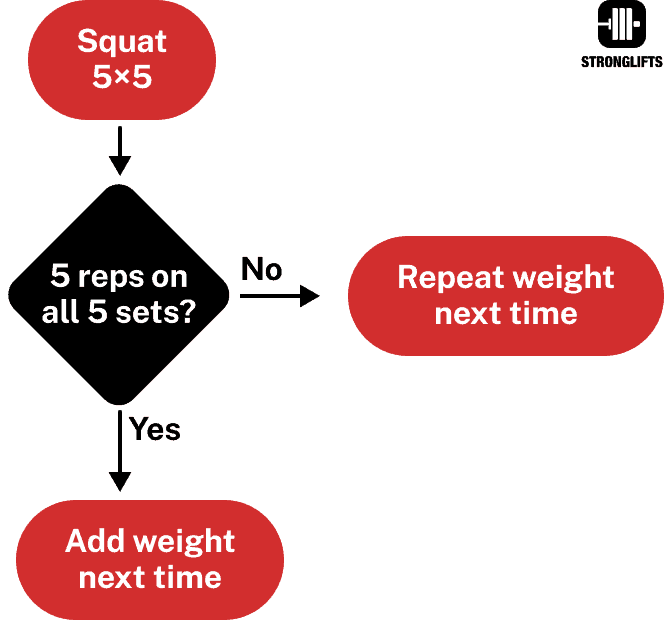
What if you completed 5×5 on Squats but not on Overhead Press? Add weight on Squats but not on Overhead Press. Like this…
| Exercise | Last workout | Next workout |
|---|---|---|
| Squat | 5×5 200lb | 5×5 205lb (+5lb) |
| Overhead Press | 5/5/5/3/3 105lb | 5×5 105b (repeat) |
| Deadlift | 5×235lb | 5×240lb (+5lb) |
Here’s how this works:
- Squats you did 5×5 200lb. You completed five reps on all five sets. Add 5lb and do 5×5 205lb next time.
- Deadlift you did 5x235lb. You also completed five reps on your top set of five. Add 5lb and do 5x240lb next time.
- Overhead Press you didn’t do 105lb for 5×5. You did 5/5/5/3/3. That’s 3 sets of 5 and 2 sets of 3 reps. Repeat the weight and try to do more reps than last time. Aim for 5×5 with 105lb.
Don’t hold back on your Squat and Deadlift if you didn’t complete 5×5 on the Overhead Press. You will not lift the same weight on all exercises. Squat and Deadlift work bigger and larger muscles. They will progress faster than Bench Press, Overhead Press and Barbell Row.
This is the progress you should expect on Stronglifts 5×5…
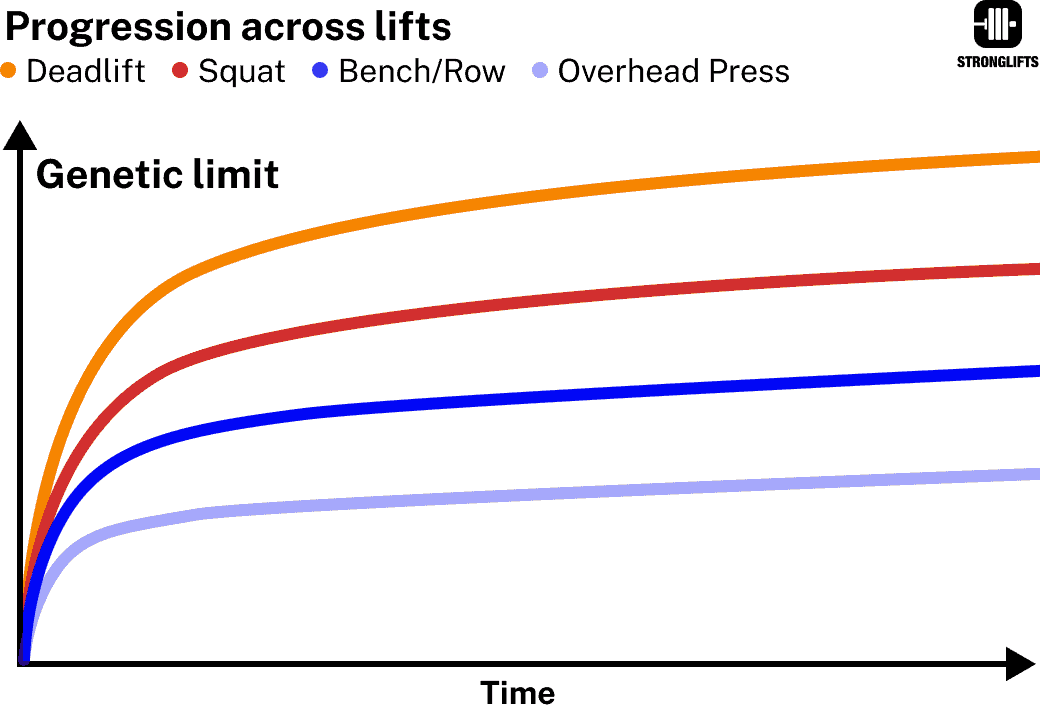
The Stronglifts app automatically adjusts the weights for you. It adds weight on the exercises you did 5×5. Otherwise it repeats it. You can focus 100% on lifting while the app does the thinking.
Good Form, Not Ego Lifting
Only add weight if you completed 5×5 with good form.
Good form means you worked your muscles through a complete range of motion, and used a technique that was safe.
Here’s the updated flow chart…
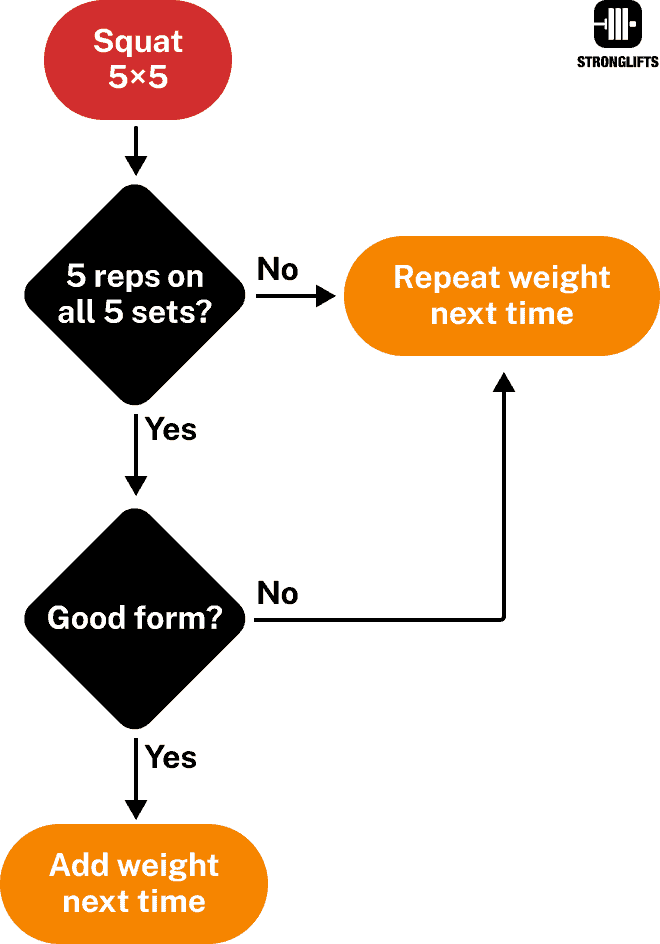
Any of the following mistakes would not be considered good form…
- Squat: your hip joint didn’t go below your knee joint (11).
- Bench: your bum came off the bench, your elbows didn’t lock (11).
- Deadlift: your hips and/or knees didn’t lock at the top (11).
- OHPress: your legs didn’t stay straight, your elbow didn’t lock.
- Barbell Row: the barbell didn’t touch your torso at the top.
Good form on the Squat is breaking parallel on every rep. This builds bigger legs than half Squats (12). If you cut your depth short on the last rep because you couldn’t have made it otherwise, you should count that as a missed rep. The Stronglifts app will repeat the weight next time instead of adding more. Squat to depth this time.
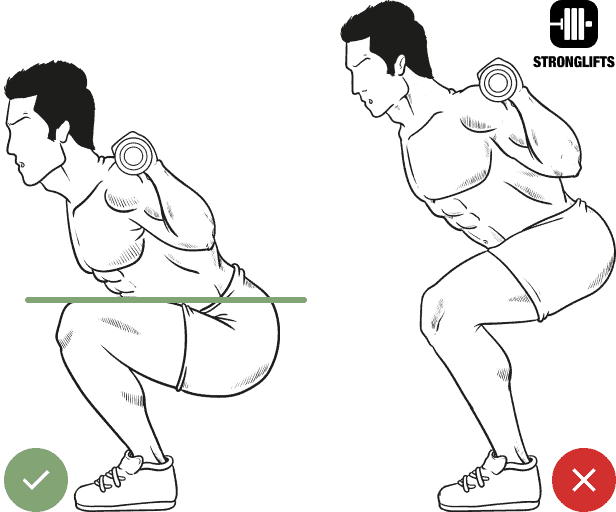
Good form on the Bench Press is keeping your bum on the bench (11). Lifting your bum makes the weight easier to lift. But it puts more stress on your lower back. Mark this as a missed rep in the Stronglifts app. Tap the set circle several times in a row to decrease the reps. The weight will repeat next workout. Keep your bum on the bench this time.
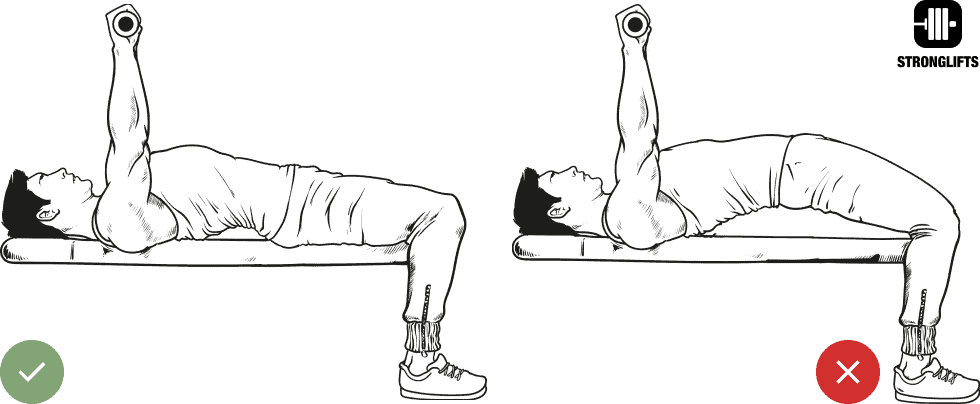
Ego lifting is lifting heavier weights than you can handle with good form. It involves sacrificing range of motion and safety in order to lift heavier weights and impress others. It’s a dead end because it results in weaknesses and can get you hurt. For example, shallow Squats will make you weak at the bottom. Sooner or later you’ll need to lower the weight to address this weakness.
The discipline is to maintain consistent technique on every rep. When you lift heavier weights, you know it’s the result of building muscle and strength, and not taking easy shortcuts that comprise your safety.
Good form does not mean perfect form.
Don’t let small imperfections hold you back from adding weight. For example, it’s fine for your knees to cave in a little when you Squat as long as it’s not excessive and doesn’t cause pain. Your body isn’t fragile. It can tolerate minor imperfections. Lifting weights has a low risk of injury (13, 14, 15). You’re more likely to get hurt on your way to the gym than in the gym.
You should strive for perfect form because that helps you lift heavier weights. But you shouldn’t be concerned if your technique isn’t flawless. Perfectionism increases the risk of injury through chronic stress (16). There will always be something you can do better. 80% perfection is good enough to progress. As long as you feel safe, add weight on the bar while trying to improve your form. You can do both at the same time.
How Much Weight to Add on Stronglifts 5×5
Progress by adding a small amount of weight on the bar.
Big weight jumps are unsustainable and result in faster plateaus. The goal isn’t to lift heavy to failure once. The goal is to consistently and systematically add weight on the bar. Small but steady increments are easier to manage and sustain. Progressive overload, not sudden or excessive overload, is what drives muscle and strength gains.
The default increment is 5lb (2.5/side). In kilograms, that’s 2.5kg or 1.25/side. The right increment depends on the exercise you do.
Compare…
| Exercise | Increment | |
|---|---|---|
| Big muscles | Squat, Deadlift | 5-10lb / 2.5-5kg |
| Small muscles | Bench, OHPress, Row | 2.5-5lb / 1.25-2.5kg |
Here’s what this means:
- Bench, Overhead Press and Rows work small muscles like the chest, shoulders and arms. Small muscles lift less weight. They progress better if you use 2.5-5lb increments (1.25-2.5/side).
- Women have less muscle than men, particularly in the upper body (17, 18). They progress better on the Overhead and Bench Press using smaller increments of 2.5lb (1.25/side).
- Squat and Deadlift work big muscles like the legs and back. They can handle 5-10lb increments. But you Squat every workout. 10lb jumps quickly add up on the Squat (it’s 30lb/week).
- That’s why I recommend men to add 5lb on the SQ, BP, OHP and Row. That’s 2.5/side. Deadlift can progress by 10lb. Once this becomes hard, switch to 5lb increments on Deadlifts too.
What if your gym doesn’t have small plates? Ask the staff. Sometimes they hide them because they’re easy to steal.
If they don’t have small plates, buy a pair and put them in your gym bag. They don’t take much space. You can also buy two small chains weighing 2.5lb each at the DIY shop. Or a pair of washers, ankle weights or magnet weights. Put that on the bar.
If your gym only has 5lb plates, you’ll need to take 10lb jumps. The less weight you lift, the harder progressing by 10lb is. Compare…
| Weight lb | Increments | % |
|---|---|---|
| 400 | 5lb | 1.3% |
| 300 | 5lb | 1.7% |
| 200 | 5lb | 2.5% |
| 100 | 5lb | 5% |
| 100 | 10lb | 10% |
| 100 | 2.5lb | 2.5% |
Here’s the difference:
- Adding 5lb to a 200lb Squat is a 2.5% increase.
- Adding 5lb to a 100lb Overhead Press is a 5% increase.
- Adding 10lb to a 100lb Overhead Press is a 10% increase. That’s like the 400lb Squatter adding 40lb on the bar!
Again, the goal is progressive overload – not sudden overload. Adding 10lb or more can work for the first workouts. But it doesn’t last. The weight jumps are too abrupt. Your body has no time to get stronger.
Just look at how much weight you’ll have to lift if you add 10lb every workout on the Overhead Press…
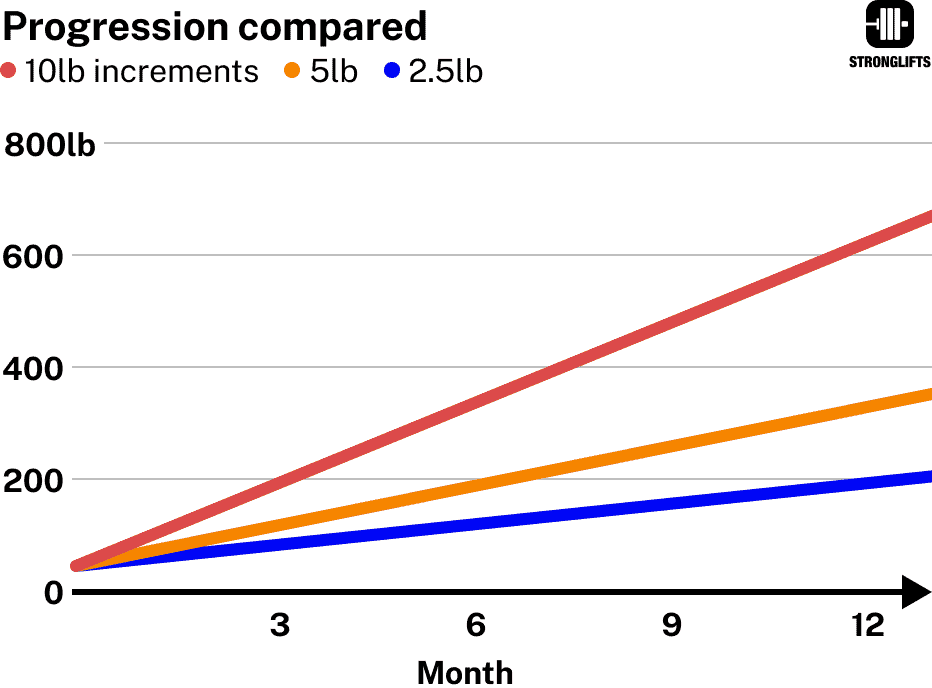
Over 600lb. Yet the world record Clean & Jerk is 588lb (19). Pressing that much without using your legs is even harder. Adding 10lb/workout on the Overhead Press would mean breaking the world record within a year. This is unrealistic and sets yourself up for disappointment.
Use realistic increments that your body can handle. Don’t use bigger increments because your gym doesn’t have small plates. Get a pair of small plates so you can use the right increments for your body.
Deadlift is the only exception where men can usually handle 10lb increments for a while. Here’s why:
- Deadlifts work more muscles than the other lifts. They work your lower and upper body. They also work large muscles like your legs and back. You’ll lift the most weight on the Deadlift.
- You have more room to progress on the Deadlift before you hit your max. Pressing 300lb overhead is a monster weight. But Deadlifting 300lb is fairly easy for most guys.
- You Squat every workout but Deadlift every other workout. Your body has more time to get stronger between Deadlifts sessions. Increasing your Squat increases your Deadlift because both exercises work similar muscles (20).
All of this makes 10lb jumps easier to handle on the Deadlift than any other lifts. But even here it doesn’t last forever. You’ll eventually need to switch to 5lb increments on the Deadlift too.
Add 5lb on the bar as a rule of thumb. If you enter your gender, weight and strength level in the Stronglifts app, you’ll get the right increments set for you. It will even adjust your increments as you get stronger on Deadlifts so you can progress longer without failing.
How Often to Add Weight
Add weight every one, two, three or even five workouts.
You don’t have to add weight every time. But you have to challenge yourself to do more eventually in order to build extra muscle and strength. If you lift the same weight for a year, you won’t look any different.
When you start Stronglifts 5×5, it’s very easy to progress by adding weight every workout. Like this…
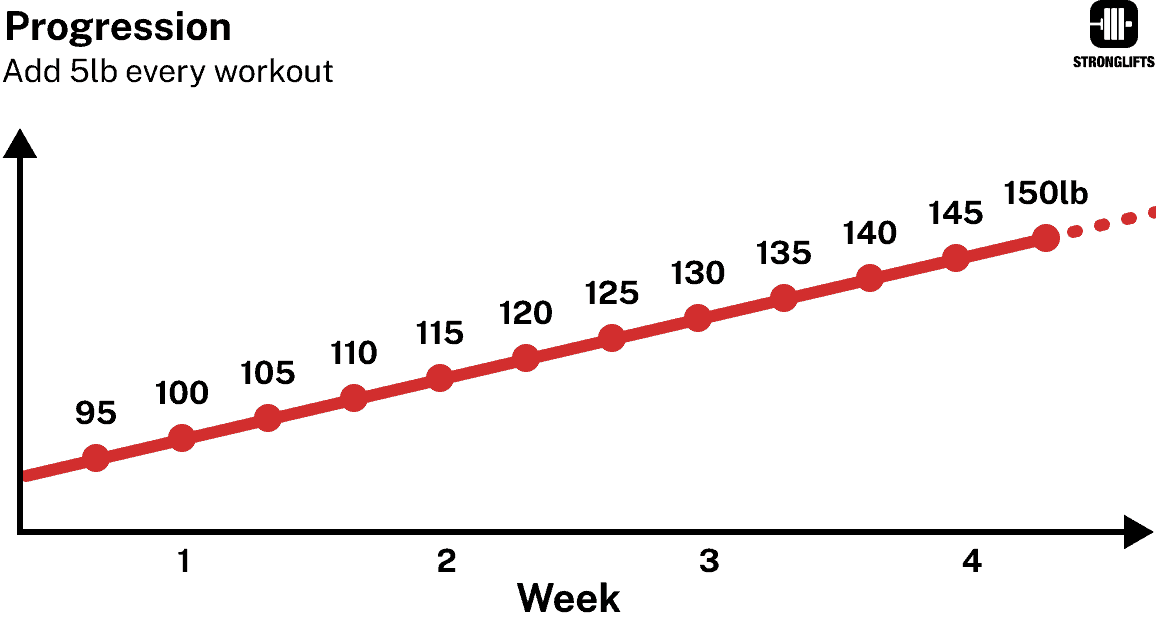
Here’s how this works:
- You Squatted 95lb for 5×5 (including the bar weight).
- Add 5lb next workout (2.5lb/side). Squat 100lb for 5×5.
- If you did 100lb for 5×5, add 5lb again the workout after. Squat 105lb for 5×5.
Say you train Monday, Wednesday and Friday. Here’s how your Squat will progress when you add weight every workout…
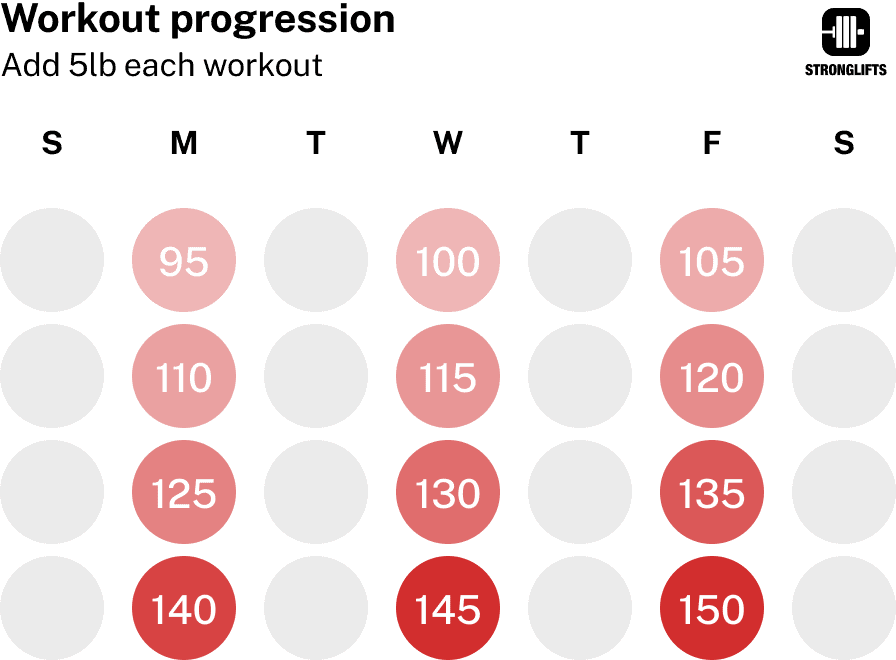
Adding weight every workout is easy during the first weeks of Stronglifts 5×5. The initial strength gains are fast because they’re mostly neural (3). Your body gets better at balancing and lifting the bar using your existing muscles. These are the easy beginner gains.
Building muscle is a slower process. It requires adding tissue. Just think of how long it takes to grow longer hair or nails. Strength gains happen faster because they’re mostly about optimizing what you already have.
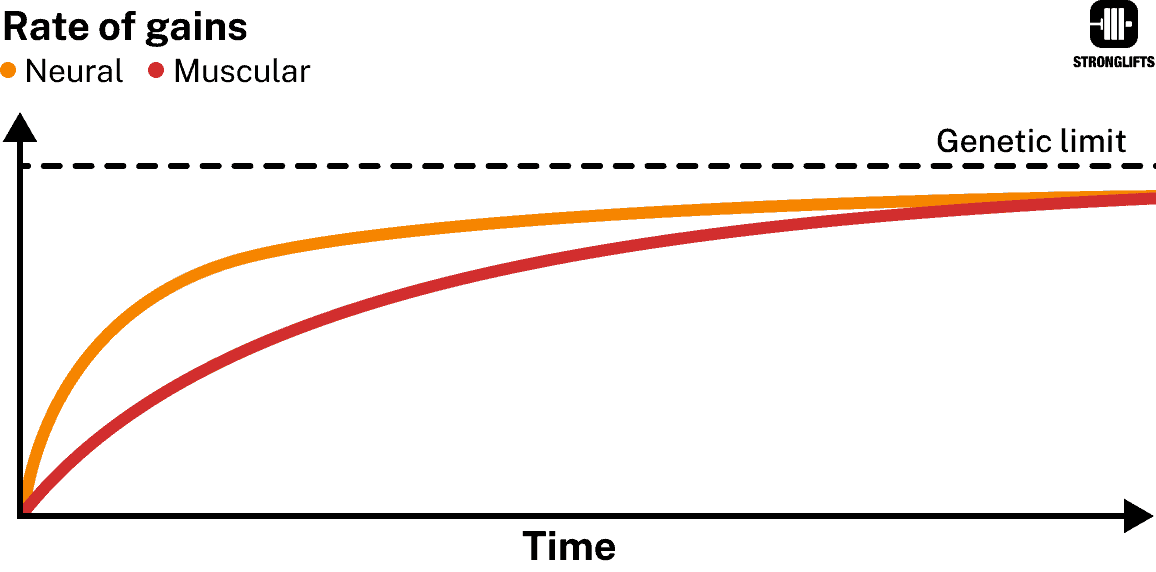
You can’t add weight every workout forever. Otherwise everyone would be Squatting +800lb in a year. Strength follows the law of diminishing returns (21). The stronger you get, the harder it is to get even stronger. The same 5lb increase that used to be easy now requires more effort.
Different people will progress at different rates. Many factors influence your ability to progress including nutrition, sleep, recovery, body weight, gender, etc. What’s universal is that all of us eventually reach a point where we can’t add weight every workout anymore.
That’s when you can slow down the progression by adding weight every three workouts instead. The weight will now increase once every 1-2 weeks depending on the exercise. Like this…
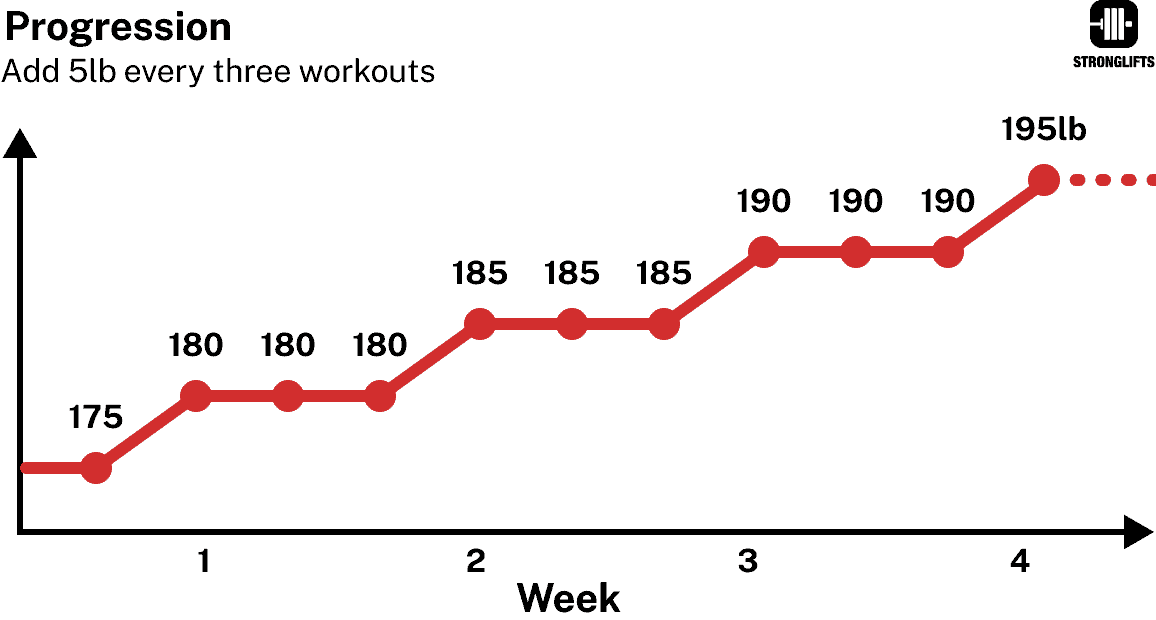
Here’s how this works:
- You Squatted 175lb for 5×5.
- Repeat 175lb for 5×5 in your next two workouts.
- Then add 5lb and do 180lb in the next workout. Stay at this weight for three workouts before going up.
Say you train Monday, Wednesday and Friday. Here’s how your Squat will progress when you add weight every three workouts…
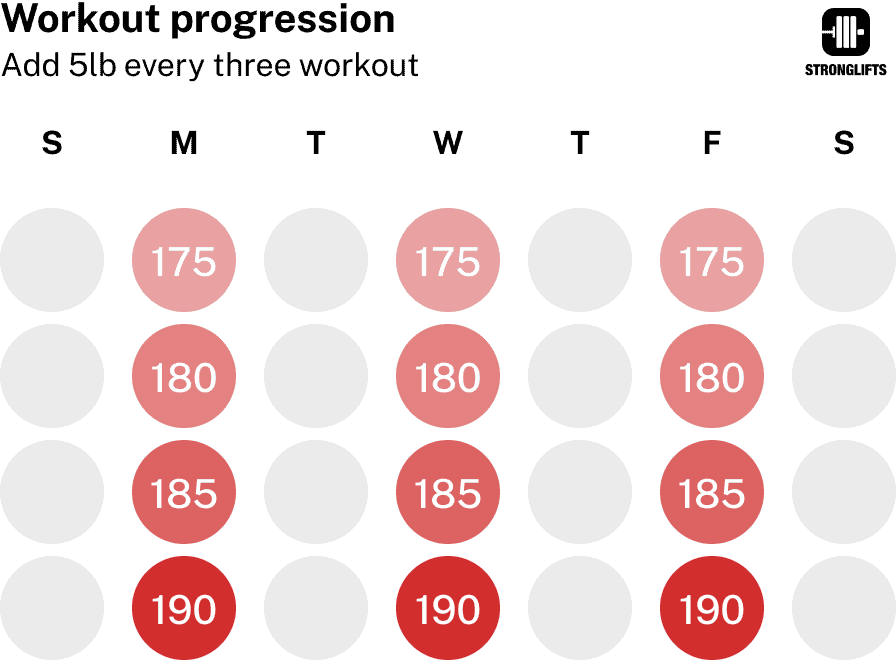
This goes back to using realistic increments that your body can handle. Switching from adding weight every workout to every three workouts slows down your progression. It looks like this…
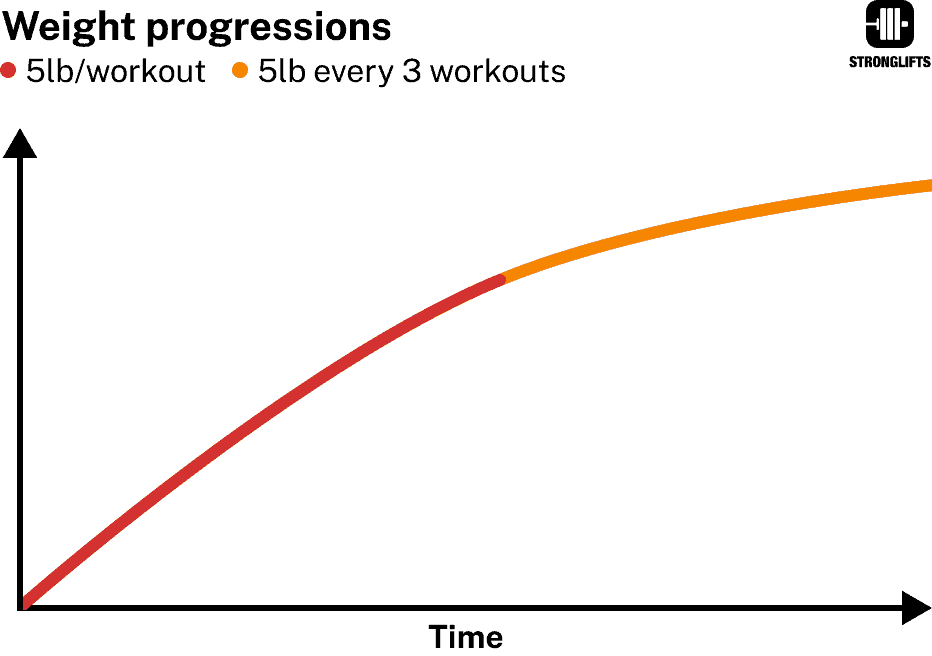
You can set the increments to increase every three workouts inside the Stronglifts app. Start workout – tap the weight – increments – change the frequency. We’ll progress the weight while you focus on lifting.
You Don’t Have to Add Weight Every Workout
Progressive overload means adding weight over time to stimulate muscle and strength gains. However this does not mean that you have to add weight every workout to get results. Nor is it realistic to expect this.
Your muscles take time to get bigger and stronger. Drug-free male lifters can typically expect to gain 20-25lb of lean muscle the first year (22). That’s only about 2lb of muscle each month or half a pound per week. Women can expect to gain half that (~10-12lb of lean muscle the first year).
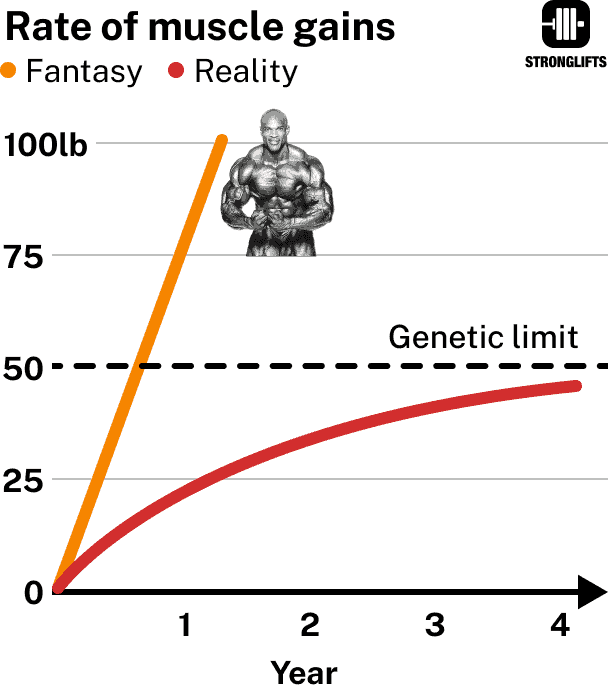
This means that Squatting one extra pound today does not mean you wake up with one extra pound of muscle tomorrow. Strength is size. More strength is more muscle. But it’s not a perfect 1:1 relationship.
If building muscle is a slower process, then the weight you lifted last workout is unlikely to matter (23). What matters is the overall trend – that you try to add weight on the bar over the course of weeks and months (rather than lifting the same weight for years like many people do).
Think of it like losing weight. It requires a caloric deficit – you need to eat less calories than you need to maintain your weight. But just because you had one deep-fried twinkie with chocolate sauce yesterday, it doesn’t mean you ruined your diet. As long as your overall calorie intake for the week and month is below maintenance level, you’ll lose weight.
Same for building muscle and strength. You have to add weight over time. But just because you didn’t add weight last workout doesn’t mean you’re not going to see progress. The stimulus that weight provides can still be enough to cause muscle and strength gains for now.
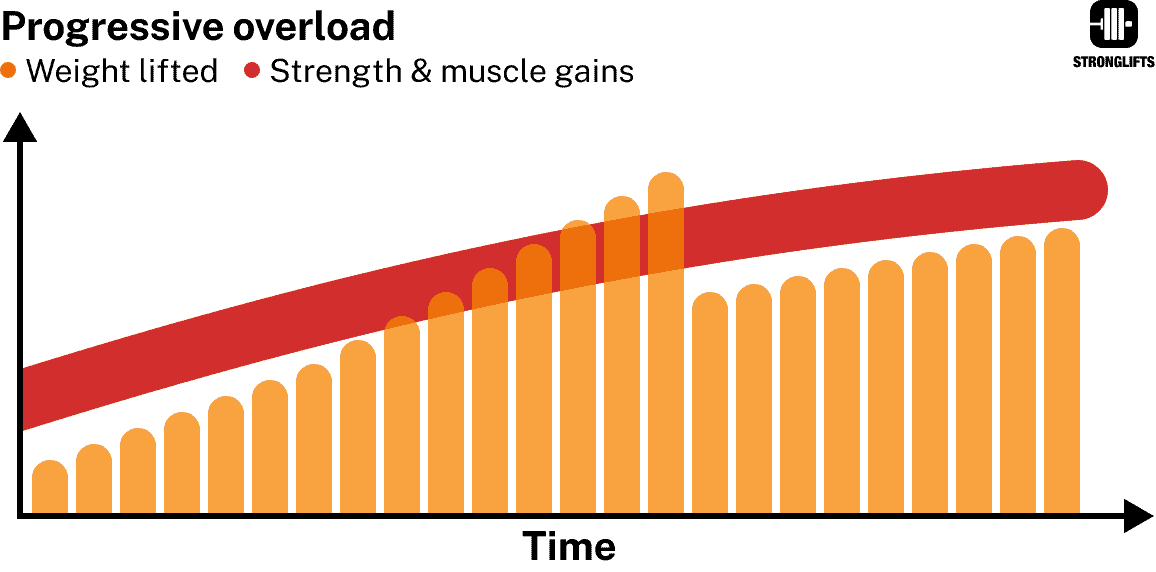
Besides, it’s unrealistic to expect to lift 5lb more every workout. Just look at the math. 5lb per workout on the Overhead Press is 360lb in a year. Add the bar and you get 405lb. How many people can Overhead Press 405lb in your gym? I bet none. It’s a monster weight.
Then why would you try to add 5lb every workout when pressing 405lb overhead in a year is unlikely for 99.9% of drug-free lifters?
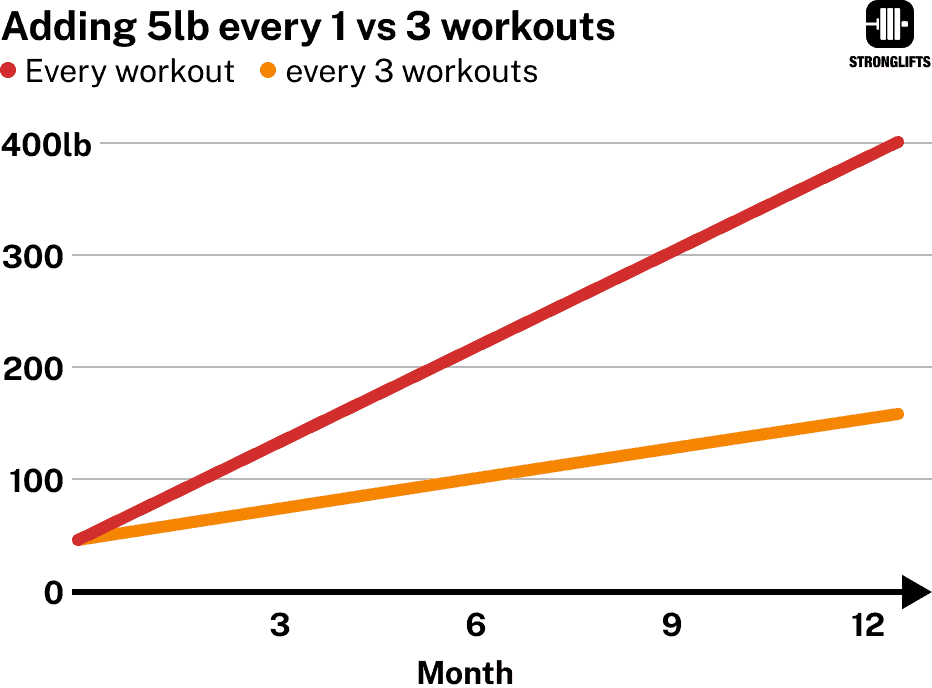
Compare with adding 5lb every 3 workouts on the Overhead Press and Bench. That’s an extra 10lb per month or 120lb per year. Add the bar and you get 165lb. That’s a respectable weight for drug-free male lifters. Say you add 5lb per workout at first on the Bench Press and get to 225lb in a year. Again, respectable numbers and much more realistic than 405lb.
The challenge is remembering how many times you’ve lifted this weight before you add more. That’s why we’ve automated this in the Stronglifts app. Set it to add weight every three workouts (start workout – tap the weight – increments). We’ll progress the weight while you focus on lifting.
Frequently Asked Questions
But you can’t add weight on the bar forever?
True. But that doesn’t mean we can’t try. Many people are surprised by how long they can add weight on the bar. They didn’t know because they never challenged themselves to lift more weight over time.
Eventually you will get stuck. You won’t be able to add weight on the bar. But there are all kinds of tricks we can use to overcome plateaus. When you reach that point, read the following guides…
- How to overcome failure on Stronglifts 5×5
- How to break plateaus on Stronglifts 5×5
- Top/back-off sets vs straight sets on Stronglifts 5×5
What if my gym lacks small plates?
Double-check first. I trained in a gym once that hid the small plates behind the reception counter. They said they were too easy to steal. You had to ask for them and return them after each use. So ask the staff.
If they don’t have small plates, buy a pair and put them in your gym bag. They don’t take much space. You’ll need one pair of 1lb and 0.25lb to progress by 2.5lb (one pair of 0.5kg and 0.125kg to progress by 1.25kg).
Here are some options:
- Rogue 1lb and 0.25lb plates
- Everymate 1lb and 0.25lb plates
- Strength Shop – 0.5kg and 0.125kg
- Rogue 0.5kg and 0.125kg plates
You can also buy two small chains weighing 2.5lb at the DIY shop. I used that in my first home gym years ago before I had fractional plates.
Or you can use a pair of washers or ankle weights. Anything that can wrap tightly around the bar is fine. I don’t recommend hanging things like water bottles to the bar. They’ll move and distract you.
Can I repeat the weight if it was too hard?
Yes.
If you lift the same weight for 5×5 next time but with less effort and/or better technique, that’s progress too. It’s fine to stay at the same weight for a few workouts. Just make sure to try to lift more at some point. Don’t lift the same weight for a year.
Can I add weight if I failed?
You can. But will you be able to lift more weight next workout?
The benefit of repeating the weight is that you get confirmation that you’re ready for an increase in weight. This makes it less likely that you’ll fail again with a heavier weight in your next workout.
What if I only failed one rep?
If you think that failed rep was only due to bad luck, then you can add weight next workout.
Say your bar path was wrong, you forgot to take a deep breath, or you weren’t focused for a moment. You think you could have completed five reps had you not made this mistake. Then add weight next time.
On the other hand, if you missed a rep on every set, then the weight is probably too heavy. Repeating the weight makes it less likely that you’ll fail again but with a heavier weight next workout.
Repeating the same weight for one workout doesn’t mean slower progress. The goal is to add weight over time. One workout without adding weight doesn’t matter as long as you’re challenging yourself to do more over the course of weeks and months. Focus on increasing the weight over time instead of being overly concerned over individual workouts.
Join the Stronglifts community to get free access to all the spreadsheets for every Stronglifts program. You’ll also get daily email tips to stay motivated. Enter your email below to sign up today for free.
References
1. Kraemer, William J, and Nicholas A Ratamess. “Fundamentals of resistance training: progression and exercise prescription.” Medicine and science in sports and exercise vol. 36,4 (2004): 674-88.
2. Garber, Carol Ewing et al. “American College of Sports Medicine position stand. Quantity and quality of exercise for developing and maintaining cardiorespiratory, musculoskeletal, and neuromotor fitness in apparently healthy adults: guidance for prescribing exercise.” Medicine and science in sports and exercise vol. 43,7 (2011): 1334-59.
3. Schoenfeld, Brad J. “The mechanisms of muscle hypertrophy and their application to resistance training.” Journal of strength and conditioning research vol. 24,10 (2010): 2857-72.
4. Chumlea, William Cameron et al. “Relations between frame size and body composition and bone mineral status.” The American journal of clinical nutrition vol. 75,6 (2002): 1012-6.
5. Peters, D M, and R Eston. “Prediction and measurement of frame size in young adult males.” Journal of sports sciences vol. 11,1 (1993): 9-15.
6. Van Etten, L M et al. “Effect of body build on weight-training-induced adaptations in body composition and muscular strength.” Medicine and science in sports and exercise vol. 26,4 (1994): 515-21.
7. Hubal, Monica J et al. “Variability in muscle size and strength gain after unilateral resistance training.” Medicine and science in sports and exercise vol. 37,6 (2005): 964-72.
8. Bhasin, S et al. “The effects of supraphysiologic doses of testosterone on muscle size and strength in normal men.” The New England journal of medicine vol. 335,1 (1996): 1-7.
9. Todd, Janice S et al. “Thomas L. DeLorme and the science of progressive resistance exercise.” Journal of strength and conditioning research vol. 26,11 (2012): 2913-23.
10. Todd, Jan et al. “Science from Strength: Thomas L. DeLorme and the Medical Acceptance of Progressive Resistance Exercise.” Iron Game History, vol. 12, no. 4, and vol. 13, no. 1, August 2014, https://starkcenter.org/research-2/iron-game-history/
11. “Technical Rules.” International Powerlifting Federation IPF – International Powerlifting Federation IPF, https://www.powerlifting.sport/rules/codes/info/technical-rules.
12. Kubo, Keitaro et al. “Effects of squat training with different depths on lower limb muscle volumes.” European journal of applied physiology vol. 119,9 (2019): 1933-1942.
13. Keogh, Justin W L, and Paul W Winwood. “The Epidemiology of Injuries Across the Weight-Training Sports.” Sports medicine (Auckland, N.Z.) vol. 47,3 (2017): 479-501.
14. Gimigliano, Francesca et al. “Epidemiology of Musculoskeletal Injuries in Adult Athletes: A Scoping Review.” Medicina (Kaunas, Lithuania) vol. 57,10 1118. 17 Oct. 2021
15. Aasa, Ulrika et al. “Injuries among weightlifters and powerlifters: a systematic review.” British journal of sports medicine vol. 51,4 (2017): 211-219.
16. Madigan, Daniel J et al. “Perfectionism predicts injury in junior athletes: Preliminary evidence from a prospective study.” Journal of sports sciences vol. 36,5 (2018): 545-550.
17. Janssen, I et al. “Skeletal muscle mass and distribution in 468 men and women aged 18-88 yr.” Journal of applied physiology (Bethesda, Md. : 1985) vol. 89,1 (2000): 81-8.
18. Miller, A E et al. “Gender differences in strength and muscle fiber characteristics.” European journal of applied physiology and occupational physiology vol. 66,3 (1993): 254-62.
19. “World Records.” International Weightlifting Federation –, https://iwf.sport/results/world-records/
20. Nigro, Federico, and Sandro Bartolomei. “A Comparison Between the Squat and the Deadlift for Lower Body Strength and Power Training.” Journal of human kinetics vol. 73 145-152. 21 Jul. 2020.
21. Latella, Christopher et al. “Long-Term Strength Adaptation: A 15-Year Analysis of Powerlifting Athletes.” Journal of strength and conditioning research vol. 34,9 (2020): 2412-2418.
22. McDonald, Lyle. “What’s My Genetic Muscular Potential?” Bodyrecomposition, 7 June 2020, https://bodyrecomposition.com/muscle-gain/genetic-muscular-potential
23. Minor, Brian et al. “Letters to the Editor: RE: Mesocycle Progression in Hypertrophy: Volume Versus Intensity.” Strength and Conditioning Journal, vol. 42, no. 5, 2020, pp. 121-124.




